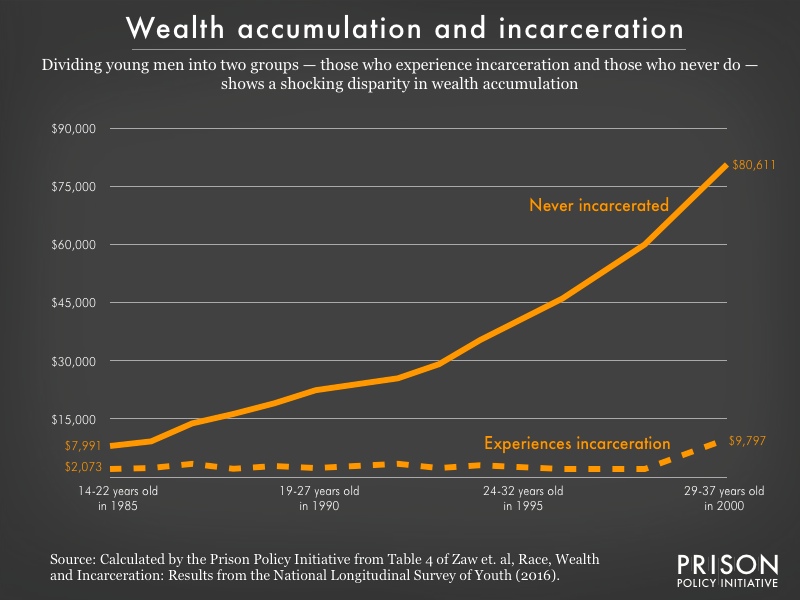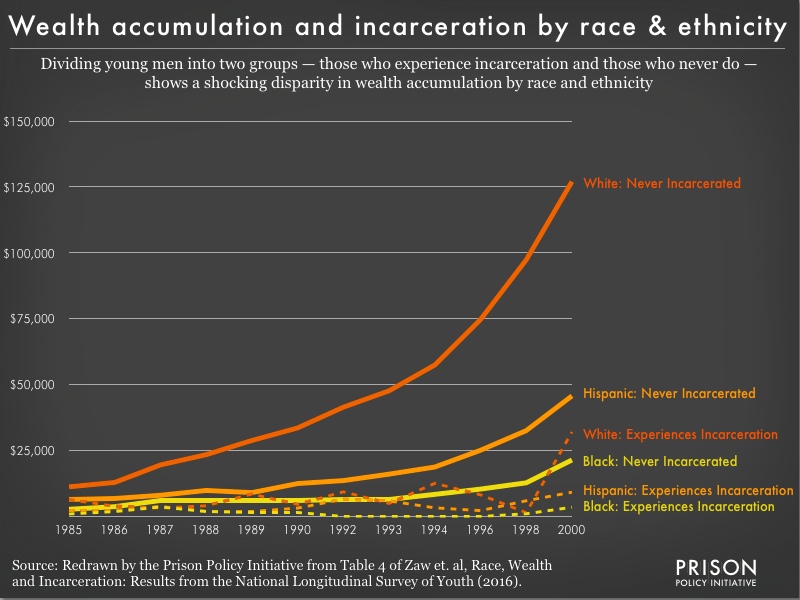The wealth of incarcerated versus non-incarcerated men over a lifetime, visualized
We make two graphs from Zaw, Hamilton, and Darity's groundbreaking dataset to illustrate the racial, ethnic and wealth disparities in incarceration.
by Meredith Booker, April 26, 2016
The wealth disparity between young men who experience prison and those who never do is staggering. A fascinating study in Race and Social Problems makes this clear. The authors Khaing Zaw, Darrick Hamilton, and William Darity, Jr. use the National Longitudinal Study of Youth to examine the personal wealth of a group of young men, following them for 27 years. When the young men are divided into two groups – those who experience incarceration at some point in their lives and those who never do – a striking disparity emerges.
 When it comes to the economic impacts of incarceration, one point becomes very clear: men who experience incarceration maintain lower levels of wealth throughout their lifetimes compared to men who are never incarcerated. This disparity is present before, during, and after a person is incarcerated. (The data stops in 2000 because of small numbers of survey respondents for some subgroups; the authors note that the wealth trends remain in the years that followed.)
When it comes to the economic impacts of incarceration, one point becomes very clear: men who experience incarceration maintain lower levels of wealth throughout their lifetimes compared to men who are never incarcerated. This disparity is present before, during, and after a person is incarcerated. (The data stops in 2000 because of small numbers of survey respondents for some subgroups; the authors note that the wealth trends remain in the years that followed.)
Once an individual is incarcerated, they often lose what little wealth they have and are left with little to no wealth accumulation. Once released, that individual may make gains in wealth accumulation, but they will always remain at significantly lower levels of wealth compared to those who are never incarcerated in their lifetime.
This is consistent with our previous conclusions about differences in pre-incarceration incomes in our report Prisons of Poverty: Uncovering the pre-incarceration incomes of the imprisoned, where we use a little-used government dataset to find that pre-incarceration incomes of incarcerated people are 41% lower than those of people of similar ages on the outside.
Looking at the same trend disaggregated by race adds another layer of detail to the story. In a press release, author Khaing Zaw says, “When it comes to wealth and incarceration outcomes, the disadvantages of being black or Hispanic compound the disadvantages of poverty.” White men that never experience incarceration will accumulate the most wealth compared to Black and Hispanic men regardless of incarceration status. At the other end of the spectrum, Black men that are incarcerated at some point in their lifetime accumulate less wealth compared to all other groups regardless of incarceration status. Later in life, this disparity endures. As the survey respondents got older, white men who experienced incarceration reported higher levels of wealth compared to Black men who had never experienced incarceration.
 Previous research in Black Wealth, White Wealth: A New Perspective on Racial Inequality highlights the gap between the wealth of white people and that of Black people. This graph shows that even white men who experienced incarceration have greater wealth than Black men who never experienced incarceration.
Previous research in Black Wealth, White Wealth: A New Perspective on Racial Inequality highlights the gap between the wealth of white people and that of Black people. This graph shows that even white men who experienced incarceration have greater wealth than Black men who never experienced incarceration.
This striking racial disparity, where even white men who have experienced incarceration accumulate wealth faster than Black men who have never experienced incarceration, brings to mind Devah Pager’s research about the impact of a criminal record on gaining employment. Pager found that between white men and Black men, white men who had a record of incarceration were more likely to be called back for a job interview compared to Black men with no history of incarceration. The “mark” of incarceration is harsh for everyone, but for Black men, it can be financially crippling for a lifetime.
The study, “Race, Wealth and Incarceration: Results from the National Longitudinal Survey of Youth” follows a cohort of youth over 27 years and presents wealth data in relation to race, sex, and incarceration status. For the graph entitled “Wealth accumulation and incarceration,” I used the tables in the article to calculate the average median wealth, weighted by the number of respondents in each racial category, for those that never experienced incarceration and those that experienced incarceration at some point, and I extrapolated the data for years 1991, 1995, 1997, and 1999.



